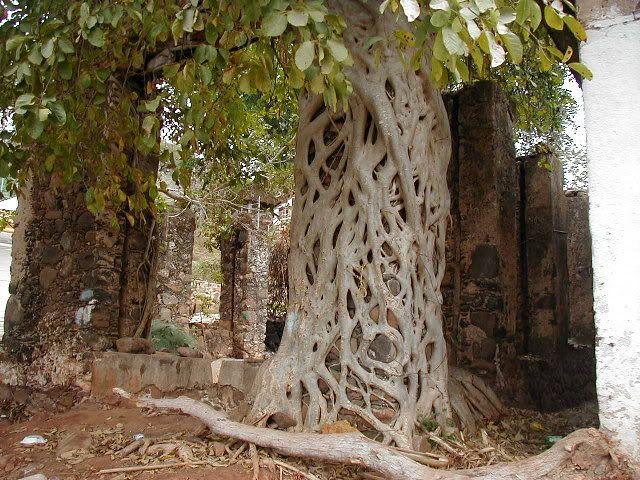A few days ago I noticed a side-bar on Page 111, entitled "Sacred Tropical Plants". I skimmed the little article, and realized that some variety of all six "sacred" plants the writer mentioned grow here. Within fifty feet of this house, including my teraza. Ficus, Banana (Musa), Frangipani (genus Plumeria) , Camellia, Jasmine, and Mango all grow right here. Made me feel kind of blessed. The idea resonated with me, because gardens always seems like a sacred places to me. And miracles happen every day in the garden.
I don't know how closely related the plant varieties in the book are to the ones found in Chacala, but I love the idea that we have sacred plants here. Even if they're just cousins.
The tree the Buddha sat under while attaining enlightenment was the Bodhi tree, one of the Ficus religiousiosa species. Some of the Ficus trees here are called Strangler Figs because they climb up other trees, and surround the trunk as it grows, until you can hardly see the original tree. They seem to have particular affection for the palm trees.

Ficus, (Strangler Fig) completely encasing a very old stone pillar in Chacala, near the muelle
The article said that Buddha was presented with a Mango grove, so he could "find repose beneath its shade". And eat all the mangos he wanted, I bet.
And for Buddhists Bananas were the symbol of the futility of earthly possessions. Apparently because they only bear fruit once. Some people believe the Banana was the fruit in the Garden of Eden, not the apple. Early botanists named the Banana the Musa paradisiaca.
Frangipani (genus Plumeria) is used by Hindus as a temple tree. Muslims plant them in cemeteries, and Buddhist plant them on the grounds of monasteries. And Republicans spray them with herbicides. Just kidding. I don't even know if many Republicans even know about Frangipani.
Camellias (Camellia japonica) are worshiped by followers of Shintoism as the "residence inhabited by the gods during their earthly transfiguration". No photo right now
Jasmine has been valued for its fragrance and its flowers for garlands for centuries.
 A Jasmine, (species nitidum) which seems
A Jasmine, (species nitidum) which seemsto have blossoms most of the year in Chacala
Thanks for the ID from Michael Loungadin
Right now I have Jasmine and Camellias here on the teraza. Bananas, Ficus, Frangipani, and Mangos are all around here. I can see three of them from the window in front of me. And a cultivated variety of Frangipani is growing in the garden of my nearest neighbor. No blossoms right now though.
Well, Chacala certainly does not meet my, or anyone's standards as a Garden of Eden,
but least Chacala it has some of it plants. That's not too bad.



2 comments:
Hi,
Interesting post! Loved the photo.
We have frangipani (plumeria) in Florida. They are quite a common landscape plant, particularly in south Florida. They do not get as big as the ones that I have seen in Hawaii. They are easy to propogate. You just take a branch and stick it in the ground.
Robert Brinkmann
Interesting article. I'm hoping someday to get some plumeria. I've seen it in a few yards but never in the viveros.
Post a Comment